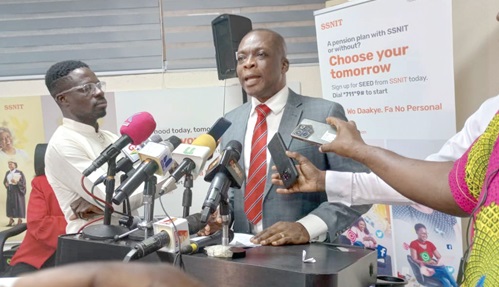
SSNIT can pay pensions beyond 2036 — Chief Actuary
The Social Security and National Insurance Trust (SSNIT) will be able to pay pensions and meet its financial obligations beyond 2036, the trust has said.
Advertisement
It indicated that the findings in the 2020 external actuarial valuation report of the International Labour Organisation (ILO), which were not different from the findings in previous reports, must not be taken in isolation.
“The trust is committed to taking measures across board to ensure sustainability of the scheme through the implementation of measures to improve returns, being more cost effective and effectively engaging government on its indebtedness.”
“Contributions of members are safe with the trust. The trust has not defaulted, and will not default in paying benefits when they are due,” the Chief Actuary, Joseph Poku, said at a news conference in Accra yesterday.
The news conference was to comment on the ILO’s 2020 Actuarial Valuation Report, which, among other things, indicated that SSNIT would not be able to pay benefits beyond the next 12 years (2036) due to depleting reserves.
The report said the total income such as contributions, investment income and other incomes would not be sufficient to pay for annual expenditures like benefit payments to pensioners by 2029.
“Starting in 2029, total income — contributions, investment income and other income — is no longer sufficient to pay for annual expenditures. “The reserve starts to decrease. During the year 2036, the reserve drops to zero,” the report said.
Response
However, addressing the media on the ILO’s report, Mr Poku stated: “Let me correct something here; we are not here to debunk the report”, emphasising that the trust’s position was to respond to “the twists and the interpretation on the report that it would collapse in the next 12 years.”
He emphasised that the ILO did the report based on figures or data up to December 2020, upon which it made the predictions.
“So, it’s not that we are disputing the report; far from that. We are trying to explain because the lay person might not understand the meaning of this,” he said. “As we speak, they are going to commission another actuary to start another actuarial valuation report as of 2023, which would probably give different results,” he said.
“We were aware of everything in the report before it even came out, and it’s not like we are disputing anything; no. There is nothing in there to dispute. We have already sought clarification and they have incorporated in the report; we are only seeking to throw more light on the outcome that some may see (to be too) technical,” he said.
Actuarial valuation
An actuarial valuation was a written report prepared and signed by the actuary valuing the scheme’s assets and calculating its liabilities, on developments affecting the scheme’s liabilities since the last actuarial valuation was prepared.
On the basis for external actuarial valuations, Mr Poku said Section 53(1) of Act 766 indicated that the trust shall obtain actuarial valuations from an external actuary. “SSNIT is mandated by law to obtain external actuarial valuation on the scheme at least once every three years.
The valuations have been done since inception, and reports submitted, including the 2020 valuation report. The most recent report is the 12th external actuarial report on the SSNIT Pension Scheme,” he said.
For instance, he said, the 2011 valuation projected that if contribution rates were not increased in the future, the annual expenditure on benefits and administration expenses would exceed the income from contributions and the fund’s assets from 2019 onwards, and that “this has not happened”.
The projection, he said, ran up to 2070.
Contribution
Again, Mr Poku said, reserve was projected to be exhausted by 2031 unless the contribution rate was increased to 16 per cent or the benefit structure changed. “The 2014 valuation report projected annual expenditures to exceed total income (contributions, investment income and other income) in 2035. The reserve starts to decrease, and during the year 2042, the reserve drops to zero.”
“The 2017 valuation report projected that total income (contributions, investment income and other income) will no longer be sufficient to pay for annual expenditures in 2032. The reserve starts to decrease. During the year 2038, the reserve drops to zero when no measure is taken,” he said, citing previous reports.
Mr Poku said the common theme in the reports was to increase the contribution rate which did not come easy as it had to involve a change in the SSNIT law and engagement with stakeholders, among others.
Coupons payment
Mr Poku said SSNIT had engaged government to ensure that it was current on monthly contribution payments, adding that previously, government had issued bonds to meet arrears and all coupon payments were met.
Recently, he said, government issued GH¢1 billion in bonds, and that discussions were ongoing for bonds to be issued. “Monthly contributions have been fully paid up to January 2024,” he said.
Advertisement




